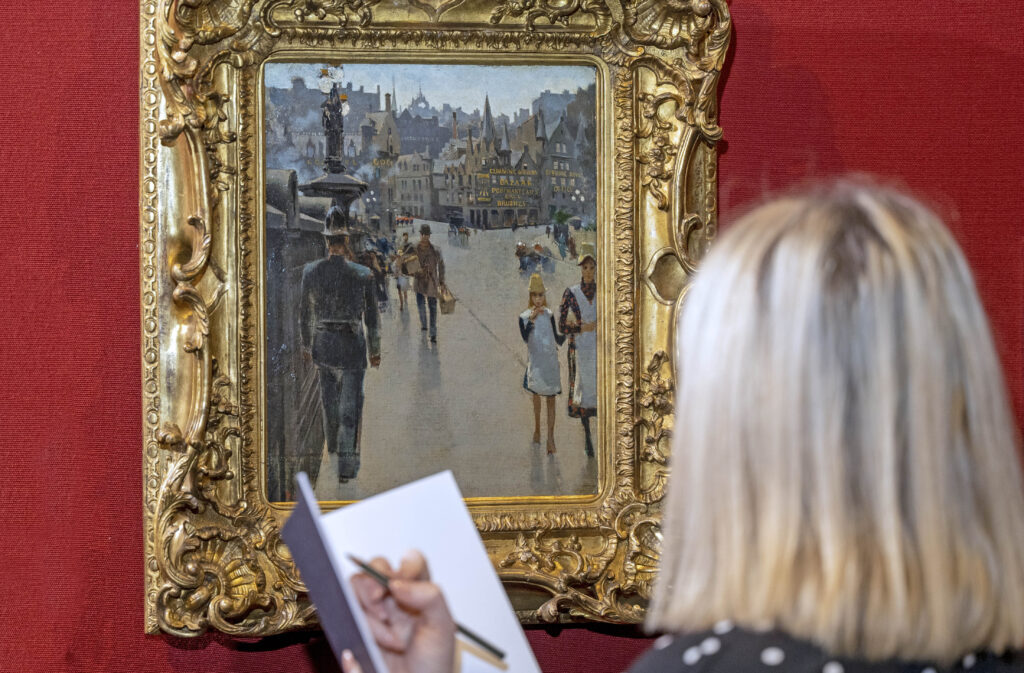National Galleries of Scotland Acquires Painting with Unique View of Edinburgh in 1881

National Galleries of Scotland (NGS) has acquired a vibrant painting by renowned Italian artist, Telemaco Signorini (1835-1901). Entitled, ‘Waverley Bridge’ (1881), the striking work depicts the recently constructed Waverley Bridge from a vantage point near its northern end. Neil Hanna Photography www.neilhannaphotography.co.uk 07702 246823
National Galleries of Scotland (NGS) has acquired a vibrant painting by renowned Italian artist, Telemaco Signorini (1835–1901), with support from Art Fund.
Entitled, ‘Waverley Bridge’ (1881), the striking work depicts the recently constructed Waverley Bridge from a vantage point near its northern end. Looking south towards the junction with Market Street and Cockburn Street, the spire of St Giles’ Cathedral is silhouetted against an overcast sky at the top.
The changing faces of the city are evident, with gas lamps on the bridge and businesses – including Cumming’s Bazaar, the offices of the Edinburgh Evening News, and the Cockburn Hotel – identified by the signage on their façades.
Smoke and vapour billow up from the steam engines in the station below. The scene is enlivened by a picturesque cast of local characters going about their business, most prominently a policeman and a mother and daughter with flower-pot hats.
Signorini painted this work during a month-long visit to Edinburgh in the early summer of 1881. In his journal for this trip the artist recorded painting on Waverley Bridge on six occasions and, given its modest size, we can be fairly confident that it was painted on the spot.
Born in Florence and based there for most of his career, Signorini is perhaps the best-known and most talented of the group of mid-19th century painters known as the Macchiaioli. Other prominent members included Giuseppe Abbati, Giovanni Fattori, and Silvestro Lega.
They were united by a commitment to a realist approach to painting, often in the open air, with bold brushwork and strong contrasts of light and shade, and by their rejection of the academic tradition of artistic training.
The term ‘Macchiaioli’ derives from the word macchia, meaning spot or blot, and was coined by a critic in 1862 in mockery of the unfinished appearance of their work, but was then adopted by them.
They are in some respects the Italian equivalents of the Barbizon and Impressionist painters in France. Signorini was the most cosmopolitan of the Macchiaioli, travelling often to Paris, and was aware of artistic developments there.
Aidan Weston-Lewis, Chief Curator of European Art at National Galleries of Scotland, says:
‘We are delighted to have secured this striking and rare little painting for the collection. We knew that Signorini had worked in Edinburgh, but only a handful of paintings resulted from his visit and none of these has appeared on the market for decades. So, when we were offered the opportunity to acquire Waverley Bridge, we jumped at the chance. It instantly becomes the most significant painting by any of the Macchiaioli artists in a British public collection.
We are confident that this will be a popular new addition to the collection, a perfect complement to our fine group of Impressionist paintings. It is a bustling image of modern urban life which recalls, in particular, the work of Gustave Caillebotte. The only surprise is that we are in Edinburgh rather than Paris.’
The acquisition was made possible through a generous grant from Art Fund, and the National Galleries of Scotland is once again extremely grateful for its support.
Sarah Philp, Director of Programme and Policy, Art Fund, said:
“At Art Fund, we believe that artworks of cultural significance should be in public collections, available to everyone. And so, with the invaluable help of our members and supporters, we’re so pleased to award £70,000 to the National Galleries of Scotland for the acquisition of this wonderful painting, Signorini’s Waverley Bridge, painted during the Italian artist’s trip to Edinburgh.”
Telemaco Signorini’s ‘Waverley Bridge’ is now on permanent display and is free to view at The Scottish National Gallery, in Edinburgh,10am -5pm, Monday-Sunday.




